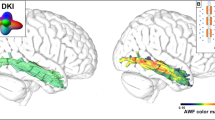Abstract
Different explanations and subtypes of conduction aphasia are analyzed. Characteristics of literal paraphasias in parietal-insular conduction aphasia are discussed, emphasizing that paraphasias in conduction aphasia are articulatory-based (articulatory literal paraphasias) and due mainly to phoneme substitutions and phoneme deletions; they result basically in switches in phoneme manner and place of articulation. Similarities between errors in ideomotor apraxia and conduction aphasia language deficits are presented. It is proposed that language deviations (in oral as in written language) in conduction aphasia can be understood as a segmentary apraxia of speech.
Similar content being viewed by others
References
Ardila, A., Montañes, P., Caro, C., Delgado, F., & Buckingham, H. W. (1989b). Phonological transformations in Spanish-speaking aphasics.Journal of Psycholinguistic Research, 18, 163–180.
Ardila, A., & Rosselli, M. (1990). Conduction aphasia and verbal apraxia.Journal of Neurolinguistics, 5, 39–48.
Ardila, A. & Rosselli, M. (1992). Repetition in aphasia.Journal of Neuorlinguistics, 7, 1–11.
Ardila, A., & Rosselli, M. (1993). Language deviations in aphasia: A frequency analysis.Brain and Language.
Ardila, A., Rosselli, M., & Pinzón, O. (1989a). Alexia and agraphia in Spanish speakers: CAT correlations and interlinguistic analysis. In A. Ardila & F. Ostrosky (Eds.),Brain organization of language and cognitive processes. (pp. 147–175). New York: Plenum Press.
Benson, D. F. (1979).Aphasia, alexia, and agraphia, New York: Churchill Livingstone.
Benson, D. F. (1988). Classical syndromes in aphasia. In F. Boller, J. Grafman, G. Rizolatti, H. Goodglass (Eds.),Handbook of neuropsychology (Vol. 1, pp. 267–280). Amsterdam: Elsevier.
Benson, D. F. & Ardila, A. (1993). Conduction aphasia. In H. Kirshner (Ed.),Handbook of speech and language disorders. New York: Marcel Dekker.
Benson, D. F., Sheremata, W. A., Bouchard, R., Segarra, S. M., Prince, D., & Geschwind, N. (1973). Conduction aphasia: A clinicopathological study.Archives of Neurology, 28, 339–346.
Brown, J. W. (1972).Aphasia, apraxia, and agnosia. Springfield, IL: Thomas.
Brown, J. M. (1975). The problem of repetition: A case study of conduction aphasia and the “isolation” syndrome.Cortex, 11, 37–52.
Buckingham, H. W. (1981). Explanations for the concept of apraxia of speech. In M. T. Sarno (Ed.),Acquired aphasia (pp. 271–302). New York: Academic Press.
Buckingham, H. W. (1989). Mechanisms underlying aphasic transformations. In A. Ardila & F. Ostrosky (Eds.),Brain organization of language and cognitive processes (pp. 123–146). New York: Plenum Press.
Caplan, D. M., Vanier, M., & Baker, C. (1986). A case study of reproduction conduction aphasia I: Word production.Cognitive Neuropsychology, 3, 99–128.
Caramazza, A., Basili, A. G., Koller, J. J. & Berndt, R. S. (1981). An investigation of repetition and language processing in a case of conduction aphasia.Brain and Language, 14, 235–271.
Damasio, H., & Damasio, A. (1980). The anatomical bases of conduction aphasia.Brain, 103, 337–350.
Damasio, H., & Damasio, A. (1983). Localization of lesions in conduction aphasia. In A. Kertesz (Ed.),Localization in neuropsychology (pp. 231–244). New York: Academic Press.
Dejerine, J. (1901).Anatomie des centres nerveux, Paris: Rueff.
Dejerine, J. (1914).Semiologie des affections du systeme nerveoux. Paris: Masson.
Demesurisse, G., & Capon, A. (1991). Brain activation during a linguistic task in conduction aphasia.Cortex, 27, 285–294.
De Renzi, E., Pieczuro, A., Vignolo, L. A. (1966). Oral apraxia and aphasia.Cortex, 2, 50–73.
Geschwind, N. (1965). Disconnection syndromes in animals and man.Brain, 88, 237–294.
Geschwind, N., & Damasio, A. (1985). Apraxia. In J. A. M. Frederiks (Ed.),Handbook of clinical neuropsychology, Vol. 45: Clinical neuropsychology (pp. 423–432). Amsterdam: Elsevier.
Goldstein, K. (1948).Language and language disturbances. New York: Grune & Stratton.
Hécaen, H., & Albert, M. (1978).Human neuropsychology. New York: Wiley.
Heilman, K. M., Rothi, L., & Kertesz, A. (1983). Localization of apraxia-producing lesions. In A. Kertesz (Ed.),Localization in neuropsychology (pp. 371–392). New York: Academic Press.
Jakobson, R. (1956). Two aspects of aphasia and two types of aphasic disturbances. In R. Jakobson & M. Halle (Eds.),Fundamentals of language (pp. 99–143). The Hague: Mouton.
Kertesz, A. (1979).Aphasia and associated disorders. New York: Grune & Stratton.
Kertesz, A. (1985). Aphasia. In J.A.M. Frederiks (Ed.),Handbook of clinical neurology, Vol. 45: Clinical neuropsychology. (pp. 287–332). Amsterdam: Elsevier.
Kleist, K. (1934).Gehirnpathologie, Leipzig: Barth.
Kohn, S. E. (1984). The nature of the phonological disorders in conduction aphasia.Brain and Language, 23, 97–115.
Kohn, S. E., & Smith, K. L. (1990). Between-word speech errors in conduction aphasia.Cognitive Neuropsychology, 7, 133–156.
Lecours, A. R., Poncet, M., Ponzio, J., & Ramade-Poncet, M. (1983). Classifications of the aphasias. In A. R. Lecours, F. Lhermitte, & B. Bryans (Eds.),Aphasiology (pp. 243–268). London: Bailliere Tindall.
Liepmann, H. (1908).Drei aufsatze aus dem apraxiegebiet, Berlin: Karger.
Luria, A. R. (1966).Higher cortical functions in man. New York: Basic Books.
Luria, A. A. (1976).Basic problems of neurolinguistics. The Hague: Mouton.
Poeck K. (1986). The clinical examination for motor apraxia.Neuropsychologia, 24, 129–134.
Poeck, K., & Kerschensteiner, M. (1975). Analysis of the sequential events in oral apraxia. In K. J. Zulch, O. Creutzfeldt, & J. C. Galbraith (Eds.),Cerebral localization (pp. 191–232) New York: Springer-Verlag.
Shallice, T., & Warrington, E. K. (1977). Auditory short-term memory impairment and conduction aphasia.Brain and Language, 4, 479–491.
Tognola, G., & Vignolo, A. L. (1980). Brain lesions associated with oral apraxia in stroke patients: A cliniconeuroradiological investigation with CT scan.Neuropsychologia, 18, 257–272.
Vinarskaya, E. N. (1971).Clinical problems of aphasia. Moscow: Meditsina (in Russian).
Wernicke, C. (1874).Der aphaiche symptomen complex. Breslau: Taschen.
Author information
Authors and Affiliations
Rights and permissions
About this article
Cite this article
Ardila, A. Phonological transformations in conduction aphasia. J Psycholinguist Res 21, 473–484 (1992). https://doi.org/10.1007/BF01067525
Issue Date:
DOI: https://doi.org/10.1007/BF01067525




